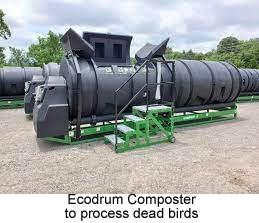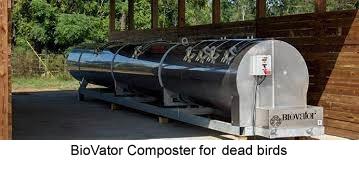Epidemiologic investigations following the 2015 epornitic of avian influenza confirmed the role of dead-bird pickup in introducing the infection onto turkey farms in Minnesota. There are many egg-production complexes that still use third-party contractors to remove dead birds requiring entry of the vehicles into barrier areas and occasionally crossing the line of separation established to exclude pathogens.
 Two manufacturers demonstrated rotary drum composters at the Midwest Poultry Federation Exhibition that resolve the problem of disposal of routine mortality and at the same time, conform to accepted standards of sustainability. Generally with continuous operation mortality can be converted to a homogenous, odorless and biologically inert fertilizer in 10 to 14 days
Two manufacturers demonstrated rotary drum composters at the Midwest Poultry Federation Exhibition that resolve the problem of disposal of routine mortality and at the same time, conform to accepted standards of sustainability. Generally with continuous operation mortality can be converted to a homogenous, odorless and biologically inert fertilizer in 10 to 14 days
Ecodrum, located in Ozark, AR, manufacture units with daily input capacity, ranging from 330 pounds to 825 pounds per day. At 0.15% mortality per week, a one-million bird complex generates 850 pounds of dead birds per day, equivalent to the capacity of the Ecodrum Model 750. The module is designed to operate year-round and is constructed from corrosion-free polyethylene. The unit, usually housed in a shed, is designed to store wood shavings or another cellulose substrate required for composting, together with equipment to receive and pack the biologically inert product. The system is equipped with a PLC controller allowing for automation of the composting process according to pre-determined cycles.
 The BIOVator, manufactured by Nioex Systems in Swan Lake, Manitoba, Canada, is fabricated from stainless steel. Available models can accommodate 60 through 1,400 pounds of compostable biological material per day.
The BIOVator, manufactured by Nioex Systems in Swan Lake, Manitoba, Canada, is fabricated from stainless steel. Available models can accommodate 60 through 1,400 pounds of compostable biological material per day.
The capital investment in a module from either manufacturer to accommodate the mortality from a one million-hen complex would be in the region of $60,000 plus the required building, power supply and access roads and loading pad.